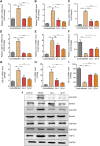Hepatoprotective Efficacy and Interventional Mechanism of Qijia Rougan Decoction in Liver Fibrosis
- PMID: 35846987
- PMCID: PMC9283647
- DOI: 10.3389/fphar.2022.911250
Hepatoprotective Efficacy and Interventional Mechanism of Qijia Rougan Decoction in Liver Fibrosis
Abstract
Liver fibrosis is a leading contributor to chronic liver diseases such as cirrhosis and liver cancer, which pose a serious health threat worldwide, and there are no effective drugs to treat it. Qijia Rougan decoction was modified from Sanjiasan, a traditional Chinese medicine (TCM) described in the "Wenyilun" manuscript. Qijia Rougan decoction possesses hepatoprotective and antifibrotic effects for clinical applications. However, its underlying mechanisms remain largely unknown. In this study, fibrotic rats induced by carbon tetrachloride (CCl4) were treated with two doses of Qijia Rougan decoction. Histopathological and serum biochemical analyses were carried out to assess liver structure and function, respectively. High-performance liquid chromatography (HPLC) coupled with mass spectrometry (MS) was performed to identify bioactive compositions in Qijia Rougan decoction. Transcriptome analysis using mRNA-sequencing (mRNA-Seq) was used to explore the underlying mechanisms and verified by quantitative real-time polymerase chain reaction (qRT-PCR) and Western blotting. Qijia Rougan decoction significantly attenuated CCl4-induced hepatic fibrotic injury, supported by promoted liver function and improved liver fibrosis. Eight main representative components originating from raw materials in the Qijia Rougan decoction were found to possess an antifibrotic role. Mechanistically, Qijia Rougan decoction regulated biological processes such as oxidation-reduction, fatty acid metabolism, cell adhesion, and transforming growth factor beta (TGFβ) signaling. We determined that Qijia Rougan decoction reversed the expression of inflammatory cytokines and inhibited the activation of fibrosis-related TGFβ signaling. It also reversed the deterioration of liver structure and function in rats induced by CCl4. Overall, Qijia Rougan decoction significantly mediated metabolism-associated processes, inhibited inflammatory reactions, and repressed fibrosis-related TGFβ signaling, which prevented liver fibrosis deterioration. Our study deepens our understanding of TCM in the diagnosis and treatment of liver fibrosis.
Keywords: inflammation; liver fibrosis; qijia rougan decoction; transcriptomics; transforming growth factor beta.
Copyright © 2022 Chen, Wang, Ji, Sun, Feng, Yu and Liu.
Conflict of interest statement
The authors declare that the research was conducted in the absence of any commercial or financial relationships that could be construed as a potential conflict of interest.
Figures








Similar articles
-
The Active Ingredients and Potential Mechanism of Qijia Rougan Decoction in Autophagy and Hepatic Stellate Cell Activation Modulation in Liver Fibrogenesis.J Anal Methods Chem. 2025 May 12;2025:4646858. doi: 10.1155/jamc/4646858. eCollection 2025. J Anal Methods Chem. 2025. PMID: 40391189 Free PMC article.
-
TMT-based proteomics analysis identifies the interventional mechanisms of Qijia Rougan decoction in improving hepatic fibrosis.J Ethnopharmacol. 2024 Jan 30;319(Pt 3):117334. doi: 10.1016/j.jep.2023.117334. Epub 2023 Oct 18. J Ethnopharmacol. 2024. PMID: 37863401
-
[Mechanism of Qijia Rougan Decoction and its disassembled formulas on regulation of VEGF/SRF/c-FOS pathway and improvement of hepatic sinusoidal capillaryization in rats with hepatic fibrosis].Zhongguo Zhong Yao Za Zhi. 2024 Oct;49(20):5528-5538. doi: 10.19540/j.cnki.cjcmm.20240710.401. Zhongguo Zhong Yao Za Zhi. 2024. PMID: 39701736 Chinese.
-
Advances in anti hepatic fibrotic therapy with Traditional Chinese Medicine herbal formula.J Ethnopharmacol. 2020 Apr 6;251:112442. doi: 10.1016/j.jep.2019.112442. Epub 2019 Dec 28. J Ethnopharmacol. 2020. PMID: 31891799 Review.
-
Efficacy and safety of Huazhi Rougan granule in the treatment of non-alcoholic fatty liver: a systematic review and meta-analysis.Ann Palliat Med. 2021 Dec;10(12):12969-12984. doi: 10.21037/apm-20-1613. Epub 2021 Feb 23. Ann Palliat Med. 2021. PMID: 33691456
Cited by
-
The gut microbiota-mediated ferroptosis pathway: a key mechanism of ginsenoside Rd against metabolism-associated fatty liver disease.Chin Med. 2025 Jun 10;20(1):83. doi: 10.1186/s13020-025-01121-1. Chin Med. 2025. PMID: 40495179 Free PMC article.
-
Gut microbes combined with metabolomics reveal the protective effects of Qijia Rougan decoction against CCl4-induced hepatic fibrosis.Front Pharmacol. 2024 Mar 28;15:1347120. doi: 10.3389/fphar.2024.1347120. eCollection 2024. Front Pharmacol. 2024. PMID: 38606180 Free PMC article.
-
Luteolin Alleviates Liver Fibrosis in Rat Hepatic Stellate Cell HSC-T6: A Proteomic Analysis.Drug Des Devel Ther. 2023 Jun 17;17:1819-1829. doi: 10.2147/DDDT.S402864. eCollection 2023. Drug Des Devel Ther. 2023. PMID: 37360572 Free PMC article.
-
Exploring the molecular mechanism of Gan Shuang granules for the treatment of non-alcoholic steatohepatitis using network pharmacology, molecular docking, and experimental verification.Front Pharmacol. 2023 Jan 24;14:1082451. doi: 10.3389/fphar.2023.1082451. eCollection 2023. Front Pharmacol. 2023. PMID: 36762105 Free PMC article.
-
Fluoride Exposure Suppresses Proliferation and Enhances Endoplasmic Reticulum Stress and Apoptosis Pathways in Hepatocytes by Downregulating Sirtuin-1.Biomed Res Int. 2022 Aug 21;2022:7380324. doi: 10.1155/2022/7380324. eCollection 2022. Biomed Res Int. 2022. Retraction in: Biomed Res Int. 2023 Dec 29;2023:9763681. doi: 10.1155/2023/9763681. PMID: 36046439 Free PMC article. Retracted.
References
LinkOut - more resources
Full Text Sources

